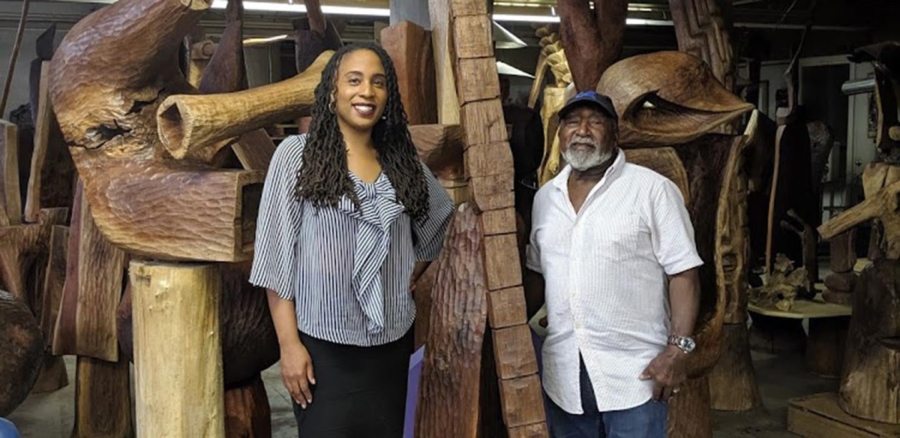September 9, 2021
Download as PDF
View on Pittwire

Daren Ellerbee and Thaddeus Mosley standing by wooden art piece.
Some 60 years ago, when the artist first began his work, Thaddeus Mosley (A&S ’50) often left his home in Pittsburgh’s St. Clair Village to take a walk in the woods. He’d make his way to McKinley Park. There he found oak, elm, sycamore and other trees fallen by the city’s forestry division as it helped to care for the forest.
Eventually, he shifted toward cherry and walnut woods, collecting them to hand carve grand, majestic pieces that seem to dance with gravity. Mosley, inspired by African tribal art and sculpture by Romanian artist Constantin Brancusi, chipped away at his craft. Now 95, Mosley has international renown. He’s still working and continues to be fascinated by tree branches and logs, believing that the wood that has roused so much of his creativity can be just as beautiful inside as out.
Daren Ellerbee, the director of Pitt’s Community Engagement Center (CEC) in Homewood, believes so, too.
Three years ago, just as the planning for the CEC began to materialize, she found herself in conversation with Mosley to have one of his pieces come “inside” to live in the center being built on North Homewood Avenue. She visited the sculptor’s North Side studio and made a selection.
Mosley, a Pitt alum, then gifted “Incremental Pillar” to the CEC. He created the walnut wood sculpture in 2015, and part of it stands 8 feet tall poised on a 2-by-2-foot base. It is a centerpiece of the art gallery that Ellerbee has collected at the CEC.
She remains awed by “Incremental Pillar,” a strong, towering figure, that she says is representative of the diverse growth and opportunities that the CEC is forging step by step to become a mainstay of community advancement in Homewood.
When Ellerbee was named director, she knew that she wanted to touch lives not only by the center’s health, education and other activities that resonate out into the neighborhood, but she also wanted to stir the souls of anyone who walked through the building’s glass doors.
She worked with Oasis Creative Space, a platform that promotes local arts and artists. One of the founders has roots in Homewood. Oasis curated African American and Afrocentric art that focused on faces, a symbolic nod to the broad diversity of Black representation.
Today, the CEC gallery has 20 pieces. It’s a place where emerging artists can have their work in the same collection as the internationally heralded Mosley and the “story they tell,” says Ellerbee, “is just as important.”
When people come into the space, she said, it’s familiar. Visitors have recognized their family and friends in the faces on the wall and in the names of the artists. For Homewood, this recognition is a continuum of the power of Black arts that the community has long nurtured.
Even more significant for Ellerbee is how the gallery pays homage to Homewood’s own artists. Included in the collection, is an untitled piece by George Hogan, the longtime chair of Harambee Ujima, who passed away last year.
The gallery is also home to a piece by Tina Brewer, a well-known fiber artist and the widow of John Brewer, a historian who lived in Homewood and chronicled its life and culture. Just before Pitt opened the CEC, historian Brewer was able to give Ellerbee a primer on the neighborhood in which the center was rising.
“I’m happy that I had a few months to sit under his wing and just to learn about the history of the community,” she said.
As the gallery pays tribute to the past, it also lays a path to the future. As the CEC moves into phase two of its development — expanding into new physical space and including more programming on health and wellness from Pitt’s Schools of Pharmacy, Education and Nursing — so, too, does the gallery move forward.
“All of this plays into the larger picture of people feeling connected to the center,” she said.
“We want young people to come in and see that we value their art as much as we value Thaddeus Mosley’s.”
At the end of the day, she explained, the gallery, in connection with the other work of the CEC, is part of the incremental steps being taken to share a fuller story of Homewood, strengthen the community and dispel some of the negative narratives that haunt the neighborhood.
It’s part of what Mosley knew all along: a romp through an art gallery can be just like a romp through the forest — life-changing.



